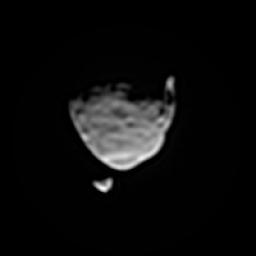
|
Two Moons of Mars in One Enhanced View
- Click the image above for a larger view
- Full-Res JPEG (200 x 200) (1.8 kB)
- Full-Res TIFF (200 x 200) (40.3 kB)
Caption:
This view of the two moons of Mars comes from a set of images taken by NASA's Mars rover Curiosity as the larger moon, Phobos, passed in front of the smaller one, Deimos, from Curiosity's perspective, on Aug. 1, 2013.
Curiosity used the telephoto-lens camera of its two-camera Mast Camera (Mastcam) instrument to catch a series of images of the moons before, during and after the occultation of Deimos by Phobos. This processed image stacks information from several images of each moon to enhance the visibility of smaller features. The two moons' position relative to each other is taken from one of the frames from just before the occultation.
On Phobos, Stickney Crater is visible on the bottom. It is on the leading hemisphere of Phobos. Hall Crater, in the south, is the prominent feature on the right hand side.
Background Info:
Malin Space Science Systems, San Diego, built and operates Mastcam. NASA's Jet Propulsion Laboratory manages the Mars Science Laboratory mission and the mission's Curiosity rover for NASA's Science Mission Directorate in Washington. The rover was designed, developed and assembled at JPL, a division of the California Institute of Technology in Pasadena.
For more about NASA's Curiosity mission, visit http://www.jpl.nasa.gov/msl , http://www.nasa.gov/mars , and http://marsprogram.jpl.nasa.gov/msl .
Cataloging Keywords:
| Name | Value | Additional Values |
|---|---|---|
| Target | Phobos | Deimos, Mars |
| System | Mars | |
| Target Type | Satellite | Planet |
| Mission | Mars Science Laboratory (MSL) | |
| Instrument Host | Curiosity Rover | |
| Host Type | Rover | |
| Instrument | Mast Camera (MastCam) | |
| Detector | ||
| Extra Keywords | Crater, Grayscale, Occultation | |
| Acquisition Date | ||
| Release Date | 2013-08-15 | |
| Date in Caption | 2013-08-01 | |
| Image Credit | NASA/JPL-Caltech/Malin Space Science Systems/Texas A&M Univ. | |
| Source | photojournal.jpl.nasa.gov/catalog/PIA17350 | |
| Identifier | PIA17350 | |
